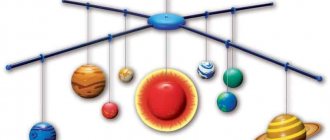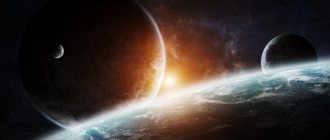Fact No. 1
The Sun is the Solar System as a whole. How can this be, because the system that is part of the galaxy is a system of planets, and the Sun is just a star, albeit the most central one. It would seem that the objects are completely different. Still, one has only to look at the Solar System in terms of its mass, and one can immediately see that the Sun occupies 98% of the total mass of the system in which humanity lives. The remaining 2% were divided to one degree or another by the 8 planets in the system, including the Earth. The lion's share of the mass is occupied by Jupiter and Saturn, the so-called “Gas Giants”. The Earth's share of the entire system accounts for an incredibly tiny mass by cosmic standards.
How did the Sun come into being?
There are different theories about the origin of the Sun. The most popular of them claims that the star was formed from a cloud of gas and dust that arose as a result of a supernova. As evidence, the argument is given that there is a large amount of uranium and gold in the central body of our star system.
Interesting fact: the radius of the Sun is 2100 times smaller than the radius of UY Scuti - the largest open star in the Universe.
Another hypothesis traces a long chain of transformations: a comet from the periphery of the Galaxy -> ice planet -> giant planet -> infrared dwarf -> yellow dwarf. By accumulating mass, the Sun, under the influence of gravitational forces, increased the density of the core to the point of launching thermonuclear reactions, and the possibility of retaining the atmosphere. Moreover, the attraction of the huge ball made it possible not to let go of even light gases: hydrogen and helium. True, from the surface of the star, they still evaporate into outer space.
Formation of the Solar System
There are several stars - analogues of the Sun in the constellations: Gemini, Scorpio, Canes Venatici, Poop, Draco. Their luminosity, temperature, mass, density and approximate age coincide with our star.
An interesting fact: the prospects for the evolution of the Sun are such that one day it will burn and devour the Earth (red giant), and then itself will take its size (white dwarf).
Fact No. 6
The sun is a multi-layered star. The visible surface of a star is only its outer layer. It is called the photosphere. The temperature on it can reach 5700 Kelvin or 15561000C, because one Kelvin is equal to 2730C.
Then, at around 70% of the solar diameter, there is a layer called “convection”. Next is a zone called "Radiant Transfer". The center of the star is the nucleus. Its temperature reaches values of at least 16,000,0000C. It now becomes clear that the solar surface is not the hottest place not only on the star, but also in the solar system as a whole.
What is the Sun made of?
In terms of its chemical composition, our luminary is no different from other stars and contains: 74.5% hydrogen (by mass), 24.6% helium, less than 1% other substances (nitrogen, oxygen, carbon, nickel, iron, silicon, chromium, magnesium and other substances). Inside the core there are continuous nuclear reactions that convert hydrogen into helium. The absolute majority of the mass of the Solar System - 99.87% belongs to the Sun.
Composition of the Sun
Interesting fact : The Sun has an almost perfect spherical shape. The difference in diameters connecting opposite points of the equator and poles is 10 kilometers. And this despite its gigantic size!
Fact No. 7
For centuries, religion refused to acknowledge the rotation of our planet around the sun. Religious leaders and their followers considered our planet to be the center of all things. It got to the point that in 1633, a physicist named Galileo Galilei was condemned for his public support of the system of the universe put forward by Nicolaus Copernicus, who argued that the planet revolved around a star. The church considered this theory to be a theory of heretics since 1616. As a result, Galileo was imprisoned for life. Later, they took pity on him, and life imprisonment was replaced by house arrest, but under the tireless eye of the Inquisition.
The church openly acknowledged that the Earth rotates around the sun in 1992. This was done by none other than the famous John Paul II. The Pope went further and admitted that Galileo's trial was wrong, calling it a "tragic misunderstanding."
Why does the sun shine?
Many philosophers and scientists have tried to answer this seemingly simple question. The ancient Greek astronomer Anaxagoras managed to go to prison for his theory of a red-hot metal ball. Clarity came with the beginning of the 20th century and the discovery of the phenomenon of radioactivity, and then the possibility of conducting controlled nuclear and thermonuclear reactions.
It was these discoveries that lifted the veil of mystery about the origin of the most common natural phenomenon. English scientists Ernest Rutherford and Arthur Eddington were the first to suggest that thermonuclear fusion reactions occur in the depths of our star. Thanks to this, the Sun's hydrogen gradually turns into helium, releasing streams of photons that we observe as light.
Ernest Rutherford
Interesting fact : the color of our star is pure white, due to the passage of layers of the earth’s atmosphere we see it: yellow, red, orange.
Fact No. 10
The existence of life on Earth is impossible without solar heat and light. However, if we imagine that the Sun will stop giving heat, then first of all, in just one week the temperature on the surface of our planet will drop to -180C. Only a year will pass and the surface of the Earth will be stable at -730C. But that’s not all, because the temperature will not stop dropping, which will certainly result in the death of all forms of life on the planet and the onset of permafrost.
Riddles about the sun
Thematic spring and summer weeks will not be complete without riddles about the sun. We have compiled for you a selection of the most interesting riddles about the sun for children aged one year and older.
What is the best way to use sun riddles? Short riddles are suitable for games with very young children from one to two years old. Classic quatrain riddles can be placed on pictures with the sun and played with preschoolers. Riddles about the sun for school-age children are entire poems that you can not only play with, but also memorize.
| We cry without him, and when he appears, we hide from him. |
| Sun |
| What is higher than the forest, More beautiful than the light, Burns without fire? |
| Sun |
| You warm the whole world And you don’t know fatigue, You smile in the window, And everyone calls you... |
| Sun |
| On the street there is a shirt, In the hut there are sleeves. |
| Ray of sunshine |
| The Fiery Eye wanders alone. Wherever he goes, he warms you with his gaze. |
| Sun |
| The scarlet ball came out over the roof for a walk in the sky in the morning. He walked, walked, walked. Met the evening - and disappeared. Where should I look for the ball now? Tell me, wind! - Tomorrow he will go for a walk again. He will go out at dawn! |
| Sun |
| In the morning, a good girl, strives to get into every house, so that everyone can feel light, cozy and warm. Well, what if this red-haired girl gets excited, There will be heat and heat, Don’t argue with me! |
| Sun |
| A golden balloon stopped over the river. And then he disappeared behind the forest, swaying over the water. |
| Sun |
| I am always friendly with the light, If the sun is in the window, I run along the wall from the mirror, from the puddle. |
| Sunny bunny |
| Someone in the morning slowly inflates a red balloon, and when he lets it out of his hands, it will suddenly become light all around. |
| Sun |
| The little blue bell rang to the little insect: “Tell me, dear, what kind of daisy is that that grew above the cloud, so yellow, bright, radiant, very big?” “This, little one, is not a flower,” she laughs in response, “This is a large luminary called... |
| Sun |
| Well, which of you will answer: It’s not a fire, but it burns painfully, It’s not a lantern, but it shines brightly, And it’s not a baker, but it bakes? |
| Sun |
| On a plate there is a bun - Golden hot side. And the plate is blue - There is no end in sight. |
| Sun and sky |
| In the morning - that's how it is! - If you open your eyelashes, And it comes to you like a pink firebird... And when it gets dark, he will come: Thin, embarrassed, - He will enter on tiptoe with a lemon wedge. The deadline has passed - she floats in a shroud of fog, round-faced and sad, as if she is not laughing... Who is he, it, she? |
| Sun, month and moon |
| Doesn't sit high, Will ride far, Walk everywhere, Keeps us all warm. |
| Sun |
| It rises and comes, but does not leave its place. |
| Sun |
| A golden cat climbs into our window. |
| Sun |
| Burn, burn brighter, To make it hotter. |
| Sun |
Return to the section riddles for children.
Fact No. 12
There is no larger object than the Sun in our galactic system. To understand the size of the star, you just have to imagine that if you filled all the space it occupies with planets like the Earth, then the star would accommodate at least 960,000 of them! And this is only if you place spherical planets in the Sun. If oblate variants of planets are placed in the star, 1,300,000 planets similar to the one on which people live will be able to fill the space occupied by the Sun. In terms of area, the surface of the sun is 11,900 times larger compared to the same indicator of the Earth.
Solar eclipse
An event such as a solar eclipse has always evoked a range of feelings among ignorant people, accompanied by horror and panic. There were also those who wanted to “warm their hands on this” and earn the authority of predictors and clairvoyants. But not only thinking creatures, but also animals react to the appearance of darkness. However, for the most part, they perceive it as the onset of night.
Interesting: Northern Lights - what they are, types, how they are formed, where they occur, photos and videos
Solar eclipse - diagrams
The scientific explanation for the phenomenon is simple: the Moon covers the Sun. This happens only during the new moon (the approximate location of all three celestial objects on the same line, and even then not always). Types of solar eclipses from the perspective of an earthly observer:
- “Private” – the satellite partially covers the star.
- “Full” – the solar disk is completely closed.
- “Ring-shaped” - the cone of the cast shadow does not reach the earth’s surface.
- “Total annular” or “hybrid” - two observers at different points simultaneously see one of the types of solar eclipses.
Solar eclipse
Observation of this phenomenon allowed us to make a number of important discoveries and examine the corona and atmosphere of the Sun. Which under normal conditions is extremely difficult. By the way, the spectacle itself does not spoil earthlings with the frequency of its appearance. The frequency of occurrence of the event is: 237 times per century.
Life cycle of the Sun
Apparently, the Sun owes its appearance to protostars of previous generations, since it contains a significant amount of metals. Its age is 4.5 -4.75 billion years, and all this time it increases its brightness and temperature (flares up).
Life cycle of stars
Interesting fact: the magnetic field of our star has a cycle of change approximately equal to 22 Earth years. Which is equal to two periods of solar activity in 11 years.
Such a physical process cannot occur without loss of mass of hydrogen, which is the main element in the composition of the star. Someday this will end, the hydrogen will burn and evaporate, and the helium will begin to shrink. The size of the star will increase until it reaches the limits of the Earth's orbit. The Sun will become a red giant and will remain in this state for approximately 120 million years. Then a nebula will appear due to a significant decrease in mass and a gigantic expansion of the outer layer. It will change from a red giant to a white dwarf, which will turn black in a few trillion years.
Interesting: Stars











